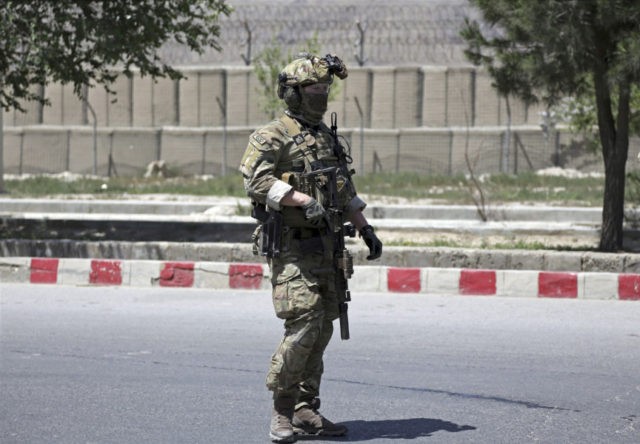The top commander of American and NATO troops in Afghanistan on Wednesday stated that the Taliban, not the Islamic State, most likely staged a deadly attack in Kabul carried out by terrorists wearing U.S. Army uniforms and driving a captured Humvee.
The Islamic State had previously attempted to take credit for the attack.
While briefing Pentagon reporters from Kabul, U.S. Gen. John Nicholson acknowledged:
We believe it was a Taliban, Haqqani attack, but we’re still developing that information. This tactic [of dressing up in American military uniforms] tracks with their tactics in the past, but more to follow on that as we learn more about the identity of the attackers. … We have seen uniforms used in the past. Frankly, it’s been well over a year, I think since we’ve seen that.
According to the Pentagon, jihadists from the Taliban- and al-Qaeda-linked Haqqani Network represent the “greatest threat” facing the American military and its allies in Afghanistan.
The attackers on Wednesday targeted the Military of Interior (MOI) compound in Kabul while wearing old U.S. military camouflage pattern uniforms, including at least one with a 101st Airborne Division patch on the sleeve, the top commander conceded.
Gen. Nicholson also confirmed that the jihadi attackers, estimated by the Afghan government to number about ten, used a captured American military Humvee to attack the MOI facility, killing at least one police officer and wounding several more people, reportedly including civilians.
Gen. Nicholson explained:
One of the attackers, I’m told, detonated his suicide vest and actually killed himself and some of his colleagues as they were conducting the attack. They never gained entrance to…the MOI headquarters, and…the special police reaction unit on menace alert status inside the city, quickly reacted and killed all these terrorists before they could gain entrance to MOI.
The general noted that the terrorist tactic of using American military uniforms to avoid detection and attack with the element of surprise has yielded concerns among the U.S.-NATO coalition, telling reporters:
It’s a concern if the enemy is wearing old uniforms that might cause a hesitation or a delay. In this case, they were in a captured Humvee. They were wearing old-style Army uniforms.
The good news is that the guards at the gate — the Afghan guards immediately recognized these as old uniforms, called on the terrorists to exit the vehicle so they could be checked out, and, at the point, the fighting started.
So it was a short, sharp fight. It obviously concerns us that terrorists have captured vehicles and captured uniforms.
Nicholson declared that the attack “failed,” stressing that the Afghan National Defense and Security Forces (ANDSF), which includes police and army units, in recent months has defeated “80 percent” of terrorist attacks primarily by the Taliban.
The general attributed the recent “improvements” to security conditions in Afghanistan to U.S. President Donald Trump’s strategy to end the war, which he said mainly focuses on “reconciliation” between Kabul and the Taliban.
Wednesday’s attack on the interior ministry facility marks the latest incident in a wave of terrorist assaults in Kabul carried out by the Taliban and ISIS.
Stars and Stripes notes:
Gunmen dressed as U.S. soldiers set off a car bomb and then tried to shoot their way into the Afghan Interior Ministry before being killed by government forces Wednesday, security officials said.
The attack — one of at least three that occurred in Afghanistan on Wednesday — targeted the Interior Ministry’s compound a few hundred yards from Kabul’s airport and a coalition air base where Americans and their allies train Afghan forces.
In its latest assessment of the nearly 17-year-old in Afghanistan, the U.S. Inspector General for Afghanistan Reconstruction (SIGAR), a watchdog agency, noted that terrorist groups in Afghanistan, mainly the Taliban, have reached the “highest level” of “control or influence” despite the unprecedented airstrike campaign launched under Trump.
Nevertheless, John Sopko, the SIGAR chief, conceded that Trump’s strategy, unveiled in August 2017, needs more time to take effect.
Under Trump, Sopko told National Public Radio (NPR), “We are seeing some changes [in Afghanistan], some positive changes, but it still is not going to be easy and it still is not going to be done anytime soon.”

COMMENTS
Please let us know if you're having issues with commenting.